It has been a couple of months since this blog has become subdued and has lacked regular updates. The excuses are many and perhaps best left unsaid. But hopefully it is a thing of past, and hopefully I will have regular updates here in the days to come. Let me begin with a set of images of children from the mountains—Himalayas to be precise—all the way from Jammu and Kashmir to Arunachal Pradesh.
When I was about to begin this post, my plan was to hastily post a few images of children from my recent trip to Lahaul and Spiti region. Looking through the impressions of those innocent faces, a thought passed to me that the children from many parts of the Himalayas look a lot alike. They all come bundled with a twinkle in their eyes and a charming innocence in their faces. I then thought it would be worthwhile making a larger compilation of images from across the mountains. Here we go!
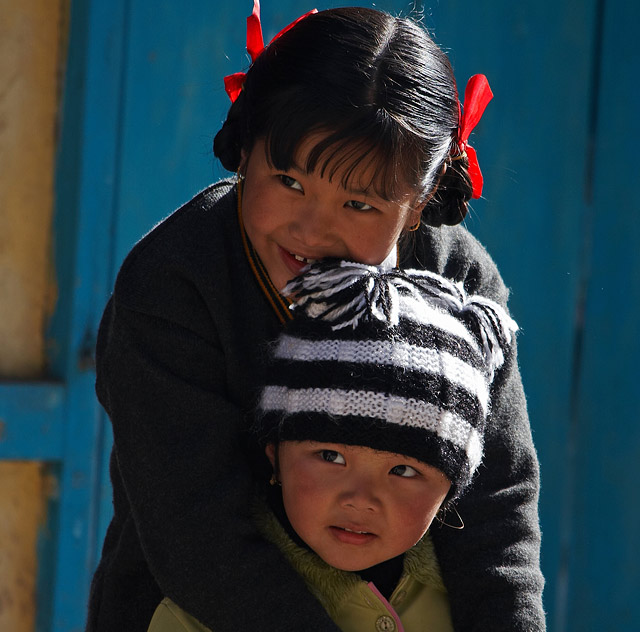
Let me begin with an old image from Tawang in Arunachal Pradesh. It is a photograph that made me happy and gave me some boasting rights. It was one of my very first images to get licensed for a reasonably good price.
On a crisp morning when we were searching for breakfast in the main street of Tawang, only to find that most restaurateurs were too lazy to serve what we wanted and preferred to offer us nothing more than a sandwich. Left without choice, sandwich is what we had to order and even that was bound to take some time to make. While the lazy cook took his time on the sandwich, I wandered the streets with my camera over the shoulder. It was the hour of the day when Indian Army bus was to come and pick up school children from their homes. This girl waited for the bus, while her little brother gave her company. I watched them chat with each other fondly for a while before making this picture.
Two years later, it was used by UNICEF for their annual calendar that had pictures of children from various ethnicities from across the world.
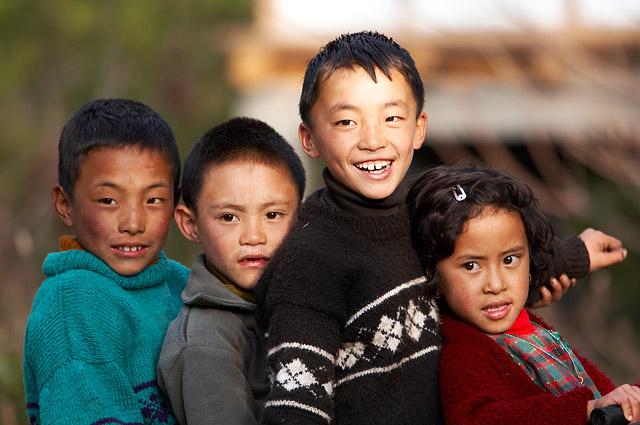
Happy, carefree children can be seen everywhere in Arunachal. All these four kids were riding on a bicycle—just one bicycle—at Jang Village on the way to Tawang. The tallest of the kids seemed to be the ‘leader of the gang’ who dictated what games they play and how they spend time. While the elders in this small village were away working, these kids were having a ball and posing happily for tourists.
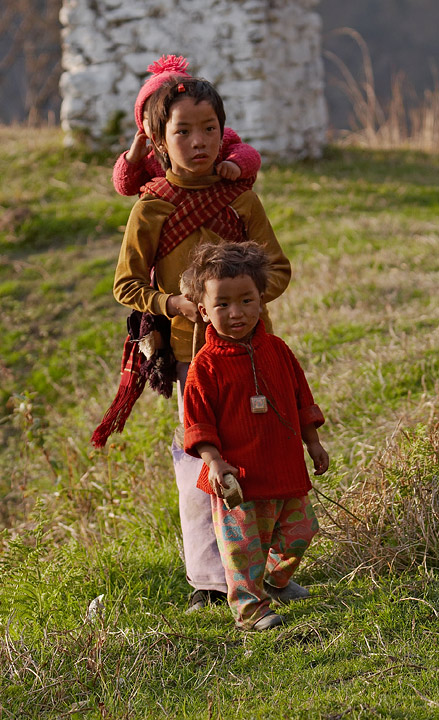
While the four kids above were having a good time, this girl was performing her duties nearby, taking care of her siblings. They seemed amused to see us, a little confused about how best to interact with us. The little kid riding on the back of her sister was shy and unsure what to do, occasionally peeping out to have a better look at us.
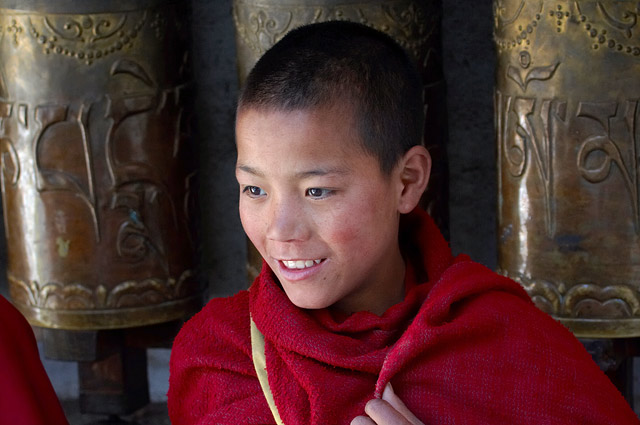
It is common to see little monks like this one—monklings as a friend once described them—giggling and running around chasing each other in the courtyard of the monasteries. We stopped by to have a chat with this fellow and his friend, but they turned from ebullient to shy when we spoke to them.
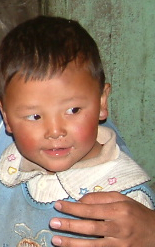 The image of this little fellow in Thangu Village is northern parts of Sikkim is perhaps the only image I have, of children in Sikkim. It is long time since I backpacked in Sikkim, a place I long to go back to but the the ordeal of reaching there keeps me out. Those were the days when I was shooting with a film camera and focused on photographing landscapes and only landscapes. Hopefully I will return there soon someday to get another dose of this beautiful mountain state.
The image of this little fellow in Thangu Village is northern parts of Sikkim is perhaps the only image I have, of children in Sikkim. It is long time since I backpacked in Sikkim, a place I long to go back to but the the ordeal of reaching there keeps me out. Those were the days when I was shooting with a film camera and focused on photographing landscapes and only landscapes. Hopefully I will return there soon someday to get another dose of this beautiful mountain state.
Uttarakhand is another region in Himalayas, from where I have no images of children. It is also another place that I visited a few times long ago, when my focus was largely on photographing landscapes. And similar to Sikkim, I hope to go back and backpack again some day soon, but haven’t made it so far thanks to the ordeal of getting there.
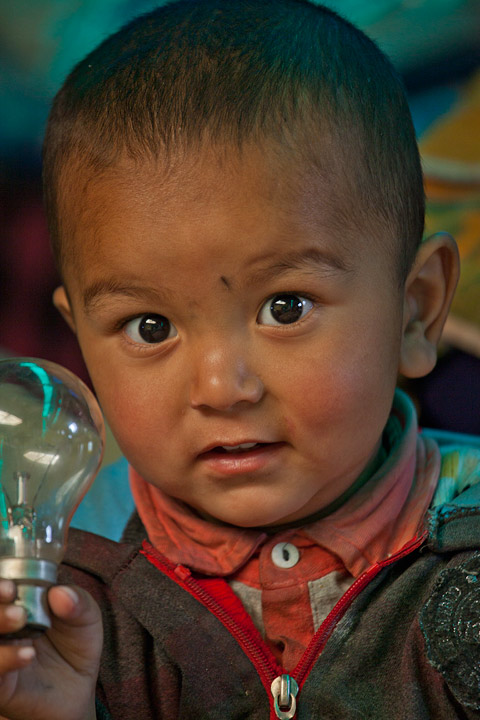
Next, when I was looking for images from Himachal Pradesh, the first that came to my mind was this little Thomas Alva Edison experimenting with his (rather dangerous) toy that was soon taken away from him. At Darcha Village, the last permanent habitation in Himachal Pradesh on the long road to Ladakh, I was tired and was not really keen to take my camera out. But one look at this guy, I knew I wasn’t left with that choice.
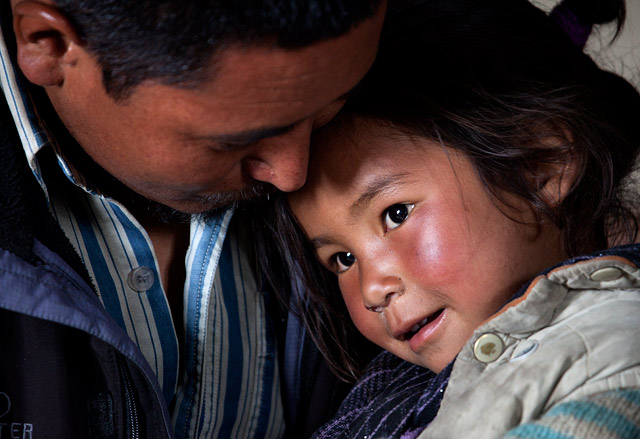
At Langcha Village in Lahaul and Spiti, we were invited for a cup of tea at the house of our guide Lara. It was a day when most of the village was in Kaza for the annual fair, having a good time watching performances. While Lara’s last daughter had no idea of the fair, she still was pleading with him to take her to Kaza, to enjoy a jeep ride. She was pacified by her father till she forgot about it.
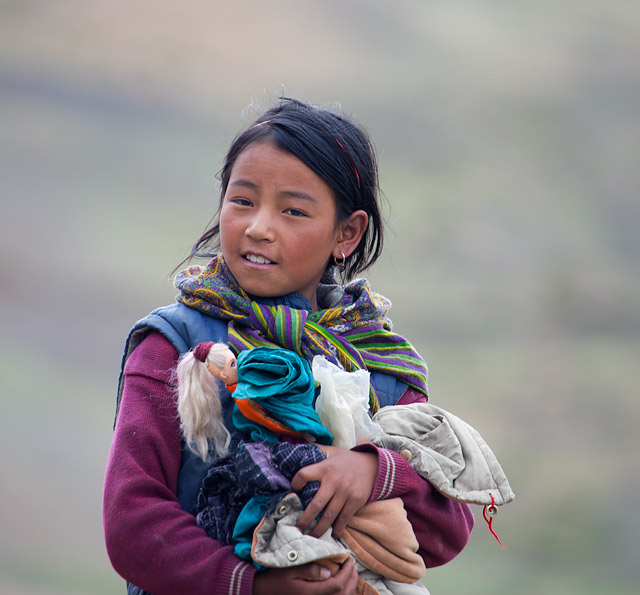
Eldest of Lara’s children, Lobsang must be about ten years old or less. Unlike other kids in the village, she had a much serious demeanour and seemed to have matured beyond her age. She also appeared obedient and spending a lot of time helping the elders with household chores besides going to school. I do not know why, but I had a feeling that she had lost her childhood sooner than one would.

Among all the children of the mountains I have seen, the Ladakhi kids are perhaps the naughtiest and the bravest. Here is a bunch of them having a good time at Korzok Gustor Festival, when monks wearing demon-like masks were performing at the courtyard of the monastery. Korzok Gustor Festival is an annual celebration at the monastery at Korzok Village, located on the banks of Tso Moriri Lake.
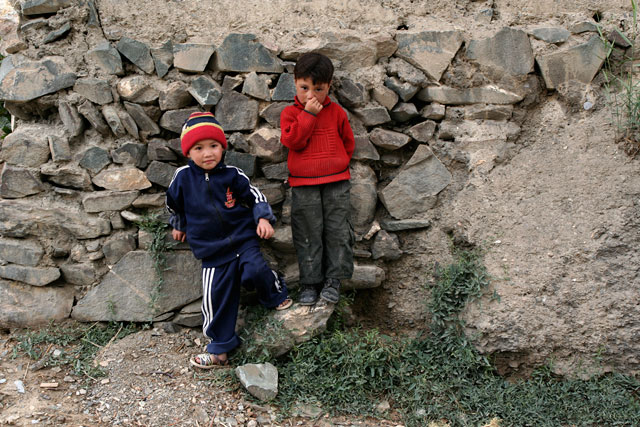
These kids were playing with stones near Lamayuru Village when I was out for a long walk. They became very conscious on seeing me and stood next to the wall, looking at me awkwardly. They were good for the camera anyway, awkward or otherwise.
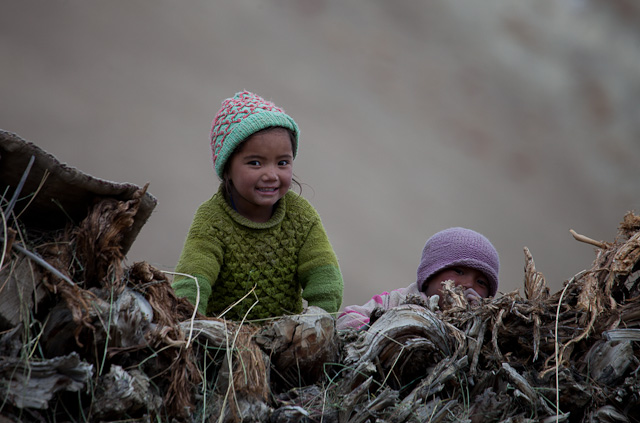
We had an awesome awesome time playing with kids in Zanskar during a cold winter season. Some of us played football with them (when the temperatures were somewhere ten degrees below zero), dragged the sledges for them or just laughed and ran around with them. In a season when Zanskar is completely cutoff by road from rest of the world and buried in snow, people of Zangle Village—kids and elders alike—were happy to have some visitors. These little siblings watched us play from their terrace. This girl called us as we were walking away and we had happy conversations in languages incomprehensible to each other.
The cheerful nature of people of Ladakh is infectious and easily rubs on to people visiting the region. It is perhaps one of the important factors besides magnificent landscapes and expansive lakes that attracts visitors from across the world to Ladakh. Here are some images of people of Ladakh.
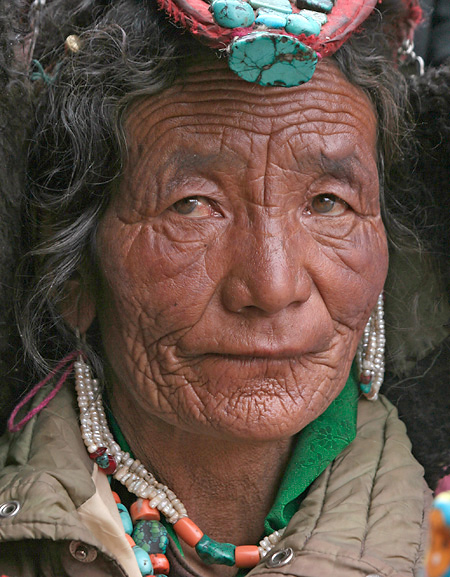
A lady at looks on as the annual Gustor Festival is in progress at Korzok Village on the banks of Tso Moriri Lake. The monastery festival is an opportunity for nomadic changspa people to get together and meet. Women adorn their turquoise jewellery and come dressed at their traditional best. People of all ages gather at the monastery, greet their friend and relative and celebrate the two-day festival that has a mix of tradition and revelry.
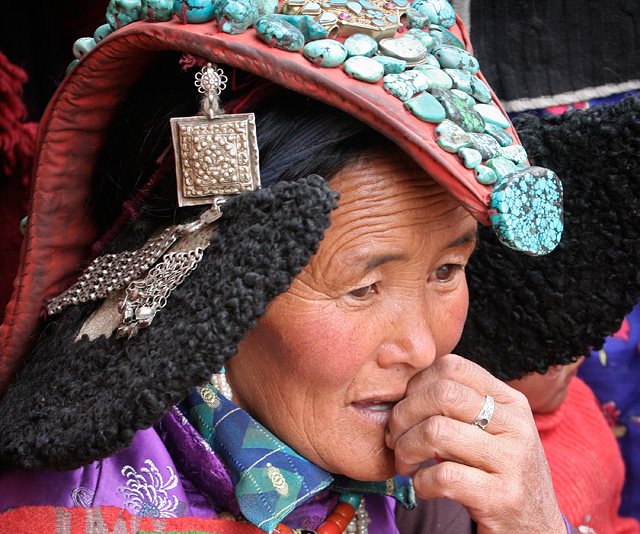
A changspa woman with her turquoise-embedded headgear at the annual Korzok Gustor Festival.
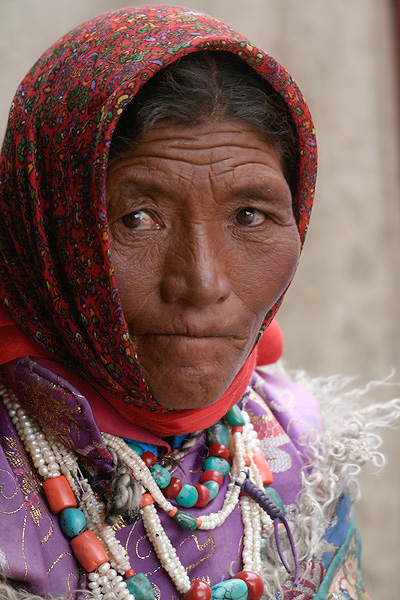
A changspa woman with her turqoise embedded jewellery at the annual Korzok Gustor Festival.
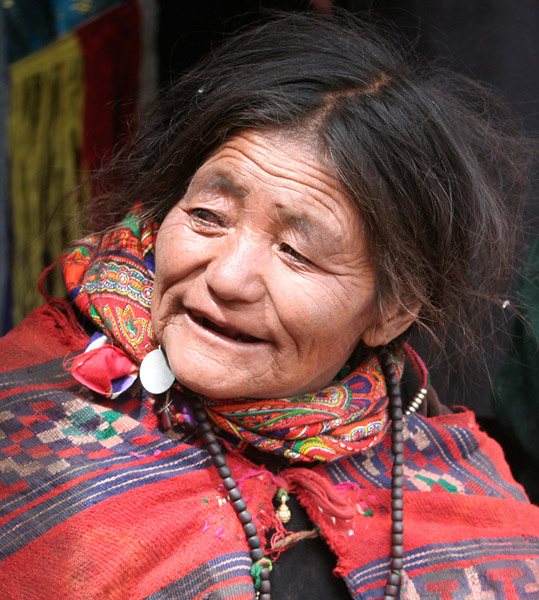
A changspa woman at Korzok Gustor Festival
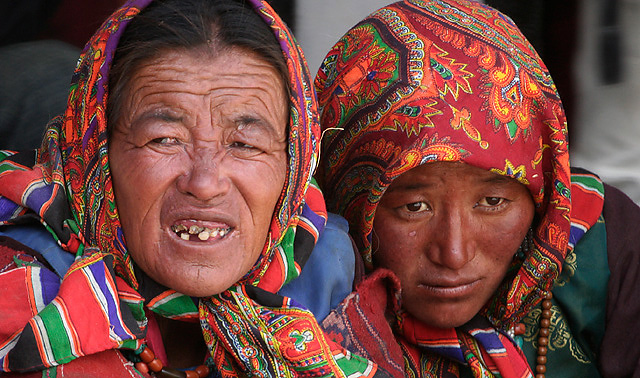
Changspa women at Korzok Gustor Festival
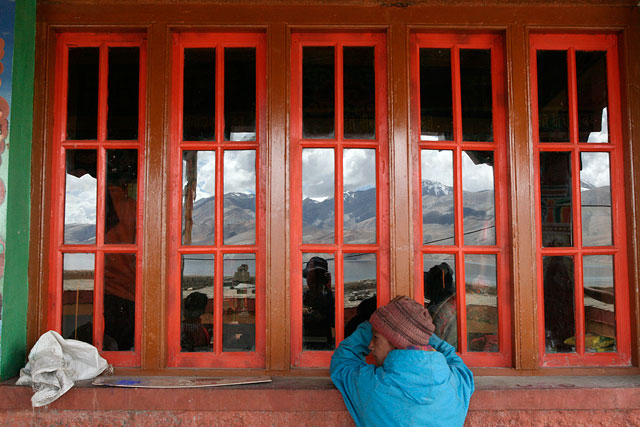
A boy peeks through the window of the prayer hall at Korzok Monastery to look at the monks getting prepared for the festivals in the room, while the mountains and Tso Moriri Lake reflect in the window.

Smiling children watching dancing monks at Korzok Gustor Festival
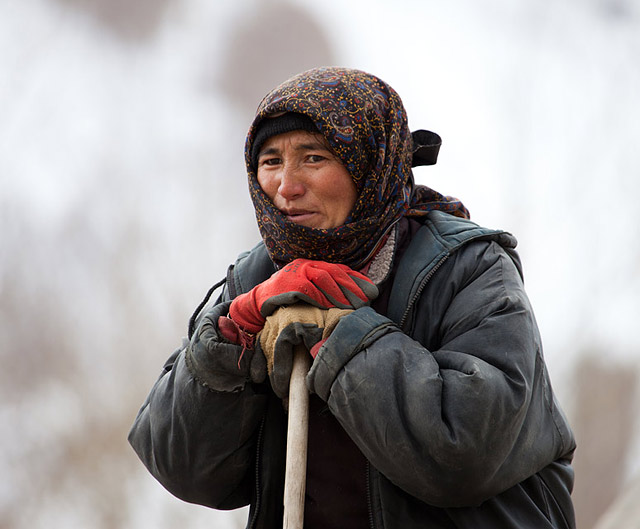
The remote Zasnkar Region gets cut off from rest of the world in the winter months, when the roads are buried in deep snow and the temperature dips 20 degrees below zero. But life must go on – the sheep have to fed, the stove must keep burning and the children must go to school. Children are going to modern schools in Zanskar only in the last few decades.
In winters, people of Zanskar rarely see new faces, except for a few adventurers who make the long walk on the frozen Zanskar River and stay for a few days in the villages before heading back. Such visitors incite the curiosity of the villagers who are always happy to begin a conversation and perhaps invite them over for a cup of tea.
This woman at Zangla Village takes a moment to talk to us at the end of day that is usually filled with lot of work even in the frigid winter months.
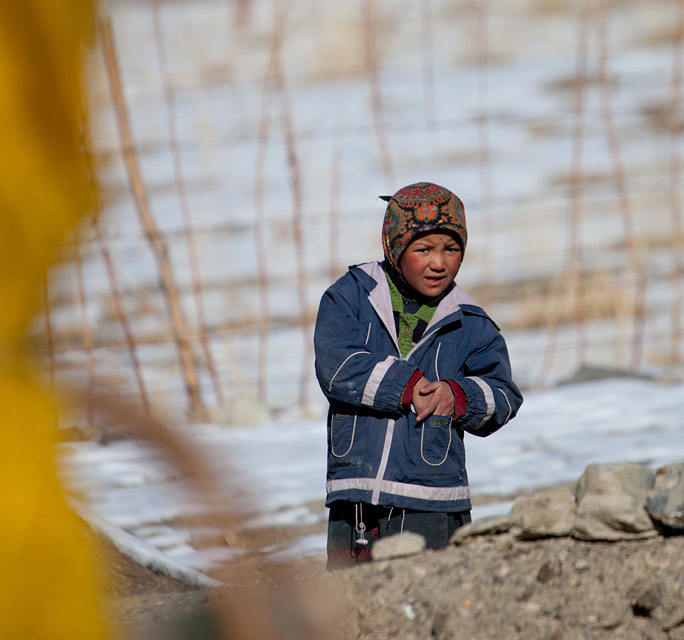
A girl pauses to speak to her mother before heading out to the school, where she will be spending her first half of the day.
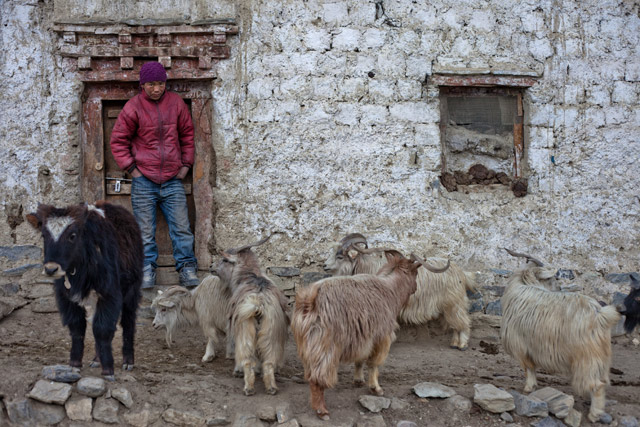
A young man has a short conversation with us before leading his sheep into a covered stable in the evening.
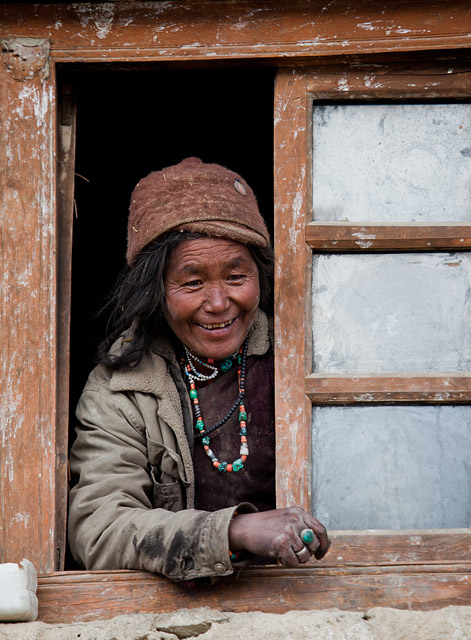
A lady is smiles at us looking through the window as we stop by to talk with her young lad taking care of his sheep nearby.
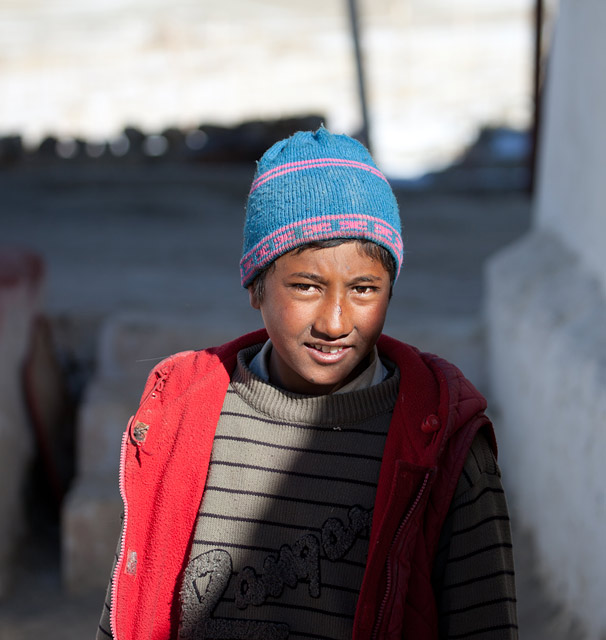
A shy boy at the house where we were staying in Zangla Village poses for the camera.
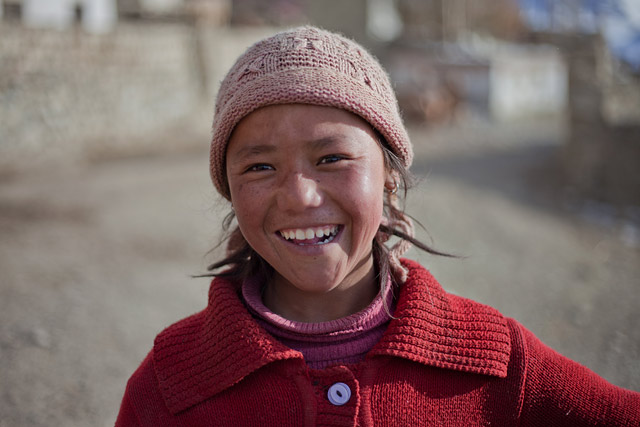
A girl smiles brightly as she starts a conversation and asks me to take her picture.
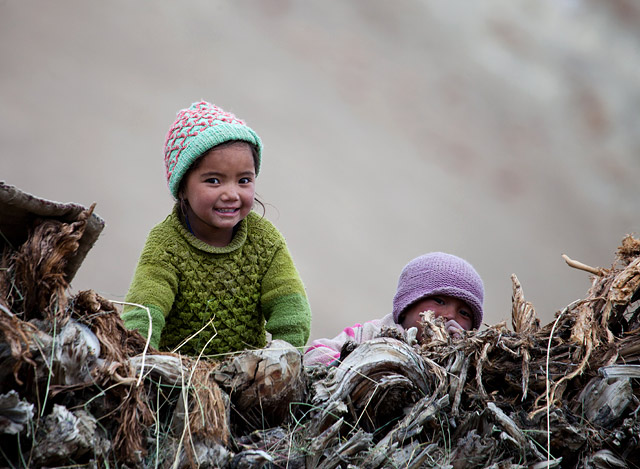
Children are happy to see new faces at their village on a cold winter evening. This little girl sang loudly to draw our attention, as her shy brother looks on hiding behind a stack of wood and hay.
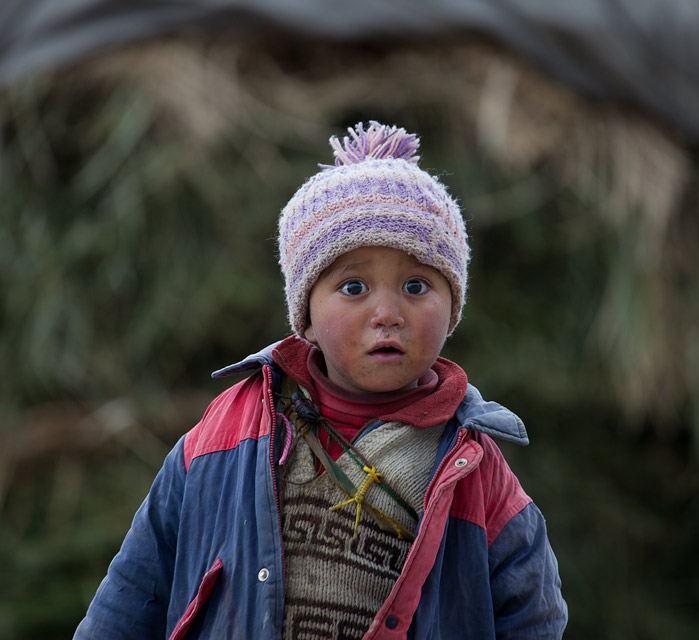
A curious young lad at Zangla Village, Zanskar.
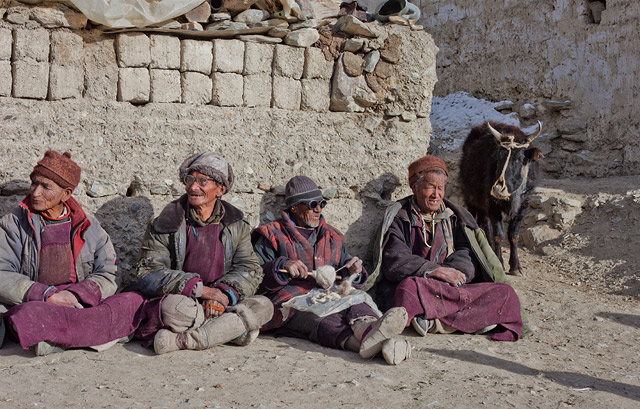
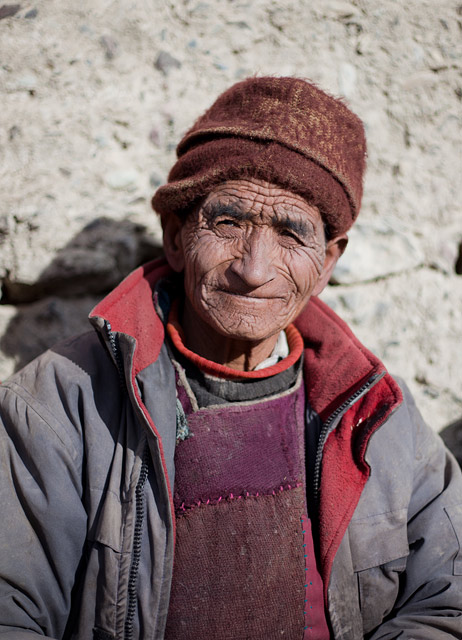
Traditionally, people gave up their ownership of land and home to their children after crossing certain age, built a khangbu—small house of their own—and retired to a life of simple living. I have never really seen a Khangbu anywhere in Ladakh. Perhaps this is a fading tradition, as I have seen houses where elders still share the family house.
In Zanskar’s Zangla Village, we saw this bunch of old men and women sunning in the evening. Some were busy knitting while everyone made some casual conversation, sometimes between themselves and sometimes with us.
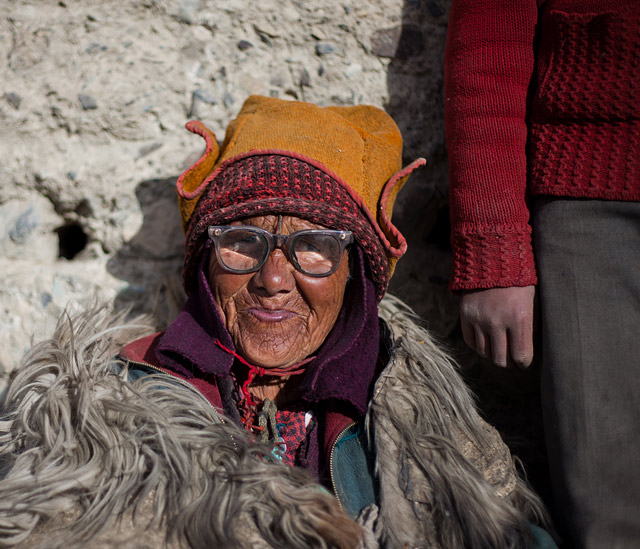
An elderly woman wearing sheepskin over traditional goncha smiles at us, while a young girl wearing a woolen sweater stands next to her.
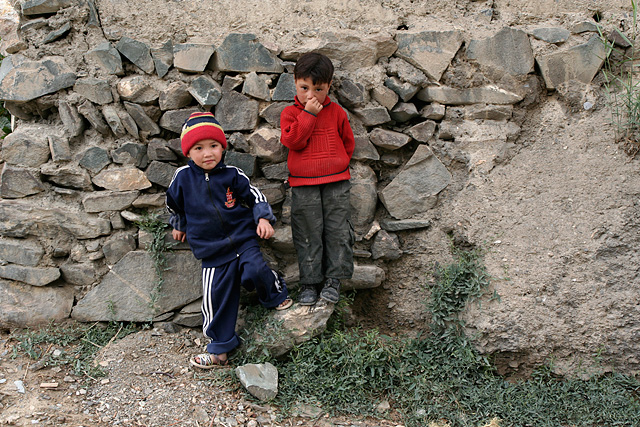
These children, who were playing quietly just outside their village at Lamayuru, pause briefly to look at the visitors.
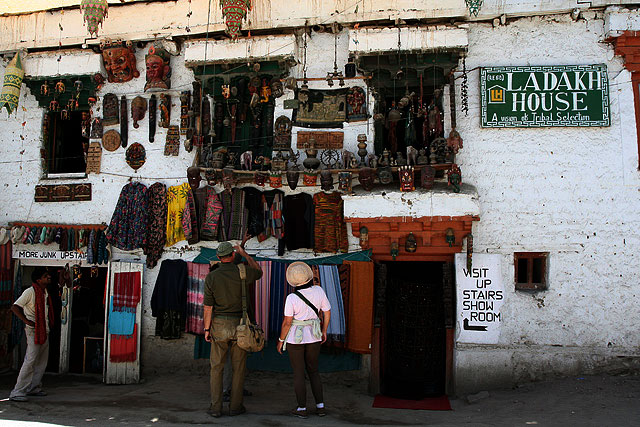
It is perhaps important to include tourists in the population of Ladakh, especially in the short summers when their numbers swell and perhaps exceeds the residents by manifolds. Leh, once a trading center and a town where several trading paths intersected and goods exchanged, now sees an influx of large number of visitors in the summer months when the weather is at its best. A good percentage of Ladakh’s population now depends on tourism income. This is also a time when there is a temporary immigration of a workforce that caters to tourists, who go back in the winter months when there are hardly any outsiders in the town.
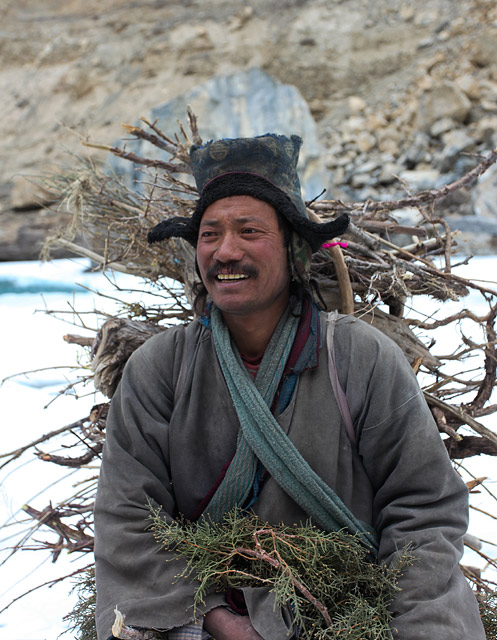
One of the great characteristics of Ladakhis is their abilities and physical strength to cope up with harsh weather and subject themselves to hard work. On a difficult expedition of walking on the frozen Zanskar River, Zanskari porters play the role of heroes who go to great extent to keep their visitors comfortable. They carry the luggages, cook and sometimes even carry trekkers on their shoulders when there is a need to step into the frigid waters. After a long day’s walk of pulling the load on their sledges, a porter still has the time for a big smile, and energy to collect a big load of wood by scouring the mountains.
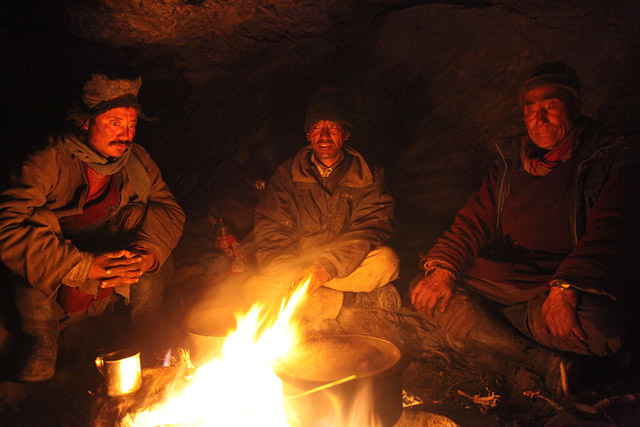
Porters warm up in a cave and cook their food as they get ready for a cold night with temperature reaching 20 degrees below zero in Zanskar.
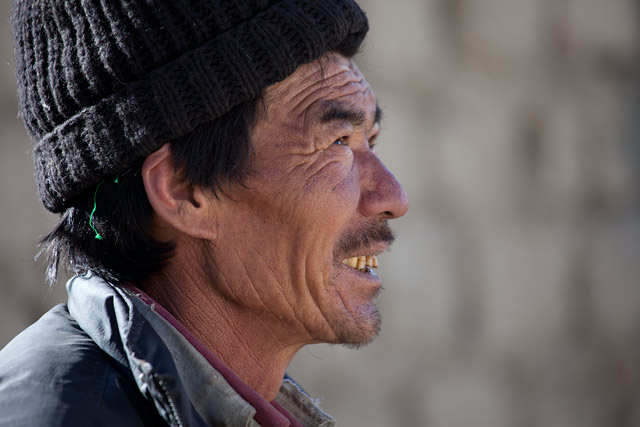
A porter who accompanied our group on the long expedition to Zanskar from Leh, walking on the frozen Zanskar River.
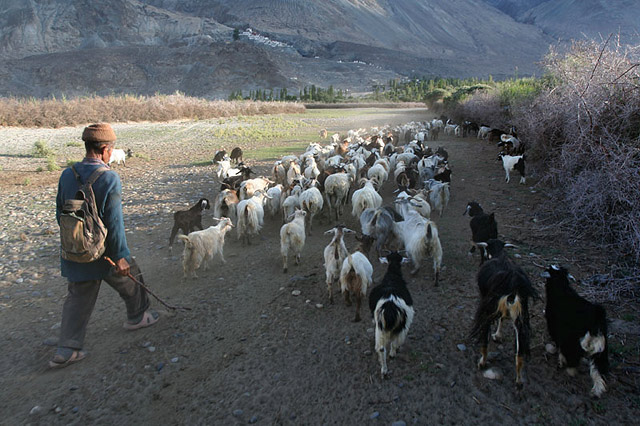
Sheep and Pashmeena Goats are an important part of Ladakh’s rural economy. While Barley fields take care of feeding the villages, Pashmeena Wool brings the much needed cash to buy everything else needed for the household. A shepherd is herding the goats back home after a day of taking them to graze in the wilderness of Nubra Valley.
Also read: my essays on the people of Ladakh.
Here is a compilation of images of heritage sites in Hampi, made during my two visits to the place this year. In these visits, I attempted to go beyond merely documenting the temples, but tried looking for new angles and perspectives to capture them. I must admit that the time I spent at each monument is far less than I would have liked to, to be able to do justice to their beauty. I believe that good pictures are made by continuous and patient observation, taking time to immerse oneself in the surroundings. There will be many more visits to Hampi in the coming years, where I hope to spend time finding more perspectives and unseen beauty of these monuments.
Also see my images of birds of Hampi.
Virupaksha Templs’s tower is the tallest and among the most prominent structures in Hampi. While the deities in all other temples in Hampi were desecrated at some point in time, Virupaksha Temple remained intact. This is the only places among the old temple where the lord is still worshiped. Also read the debate on why Virupaksha Temple was not desecrated, on Anu’s blog.
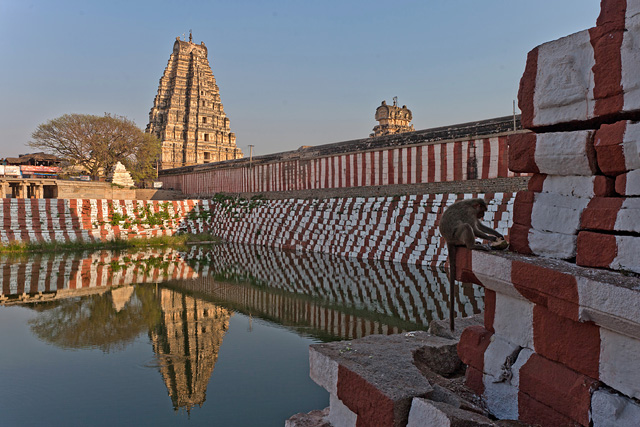
The insides of Virupaksha Temple.
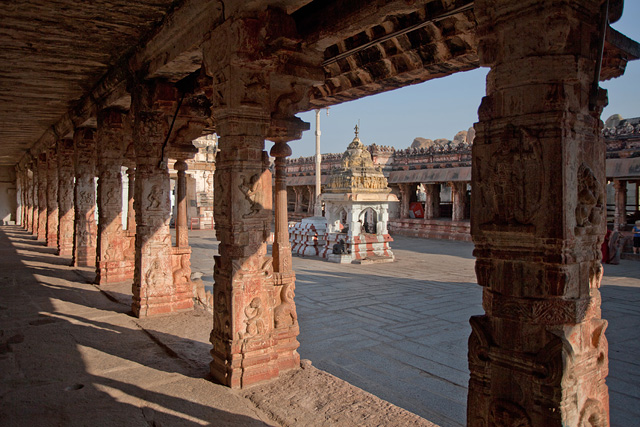
More views of Virupaksha Temple, taken from nearby Hemakuta Hill.
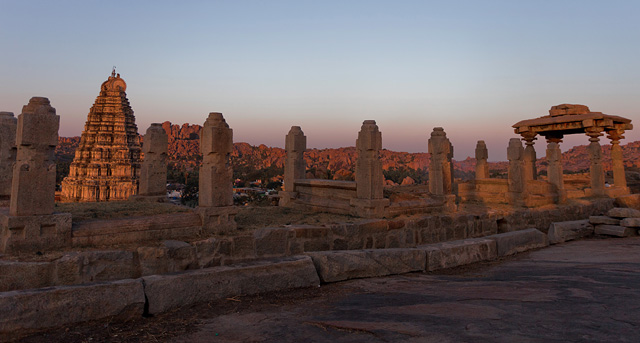
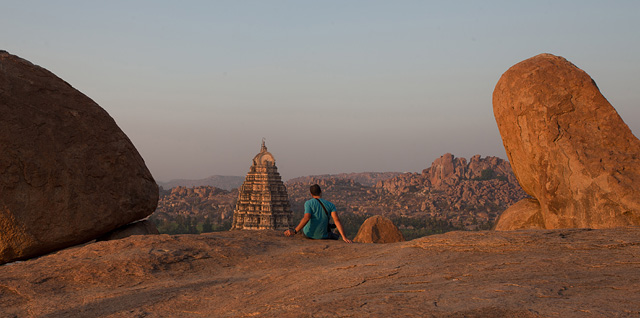
And here is how Hemakuta Hill looks from the courtyard of Virupaksha Temple. People arrive at the Hemakuta Hill in the evening hours to see the beautiful vistas of a boulder-strewn landscape and to watch the sunset. This picture was taken about thirty minutes before the hour of sunset.
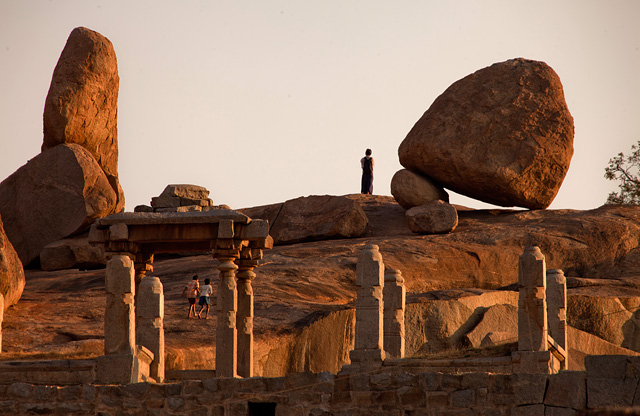
Here is a mendicant on one of the mantapas on Hemakuta Hill.
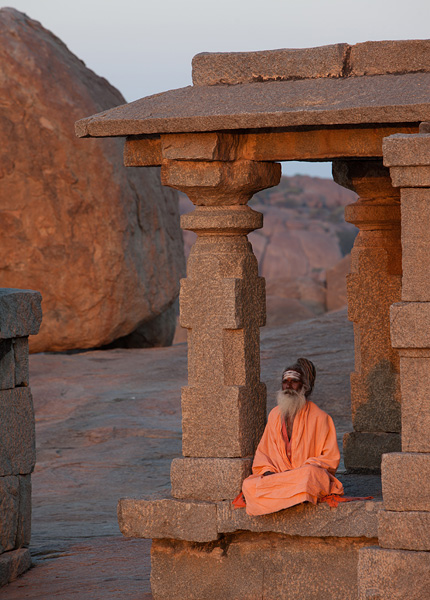
A long avenue, called Hampi Bazaar, located in front of Virupaksha Temple is said to be the place that symbolized the past riches of Hampi. This is where gold and diamonds were sold by the street side in the heydays of Vijayanagar Kingdom. Even today, a long shelter with hundreds of pillars has remained on both sides of the avenue, which once served as shops selling the riches. To the other end of the avenue is Matanga Parvata, said to be the highest point in Hampi. This mantapa is at the base of Matanga Parvata about a kilometer away from Virupaksha Temple at the other end of the avenue.
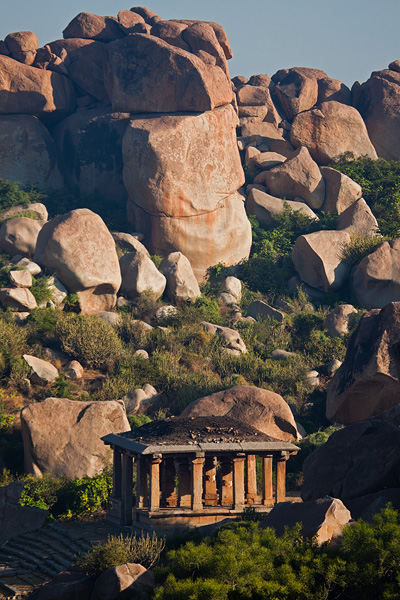
To the other side of Matanga Hill Achutaraya Temple, seen in the picture below.
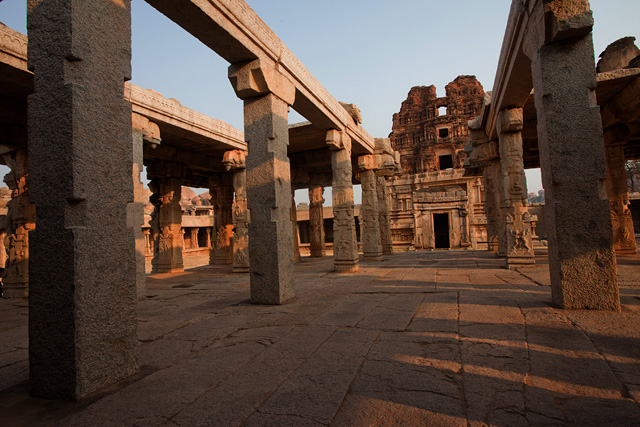
Similar to the bazaar in front of Virupaksha Temple, Achutaraya Temple also boasts of a wide and long avenue which once had shops lined on both sides. This Kalyani is at the other end of Achutaraya Bazaar.
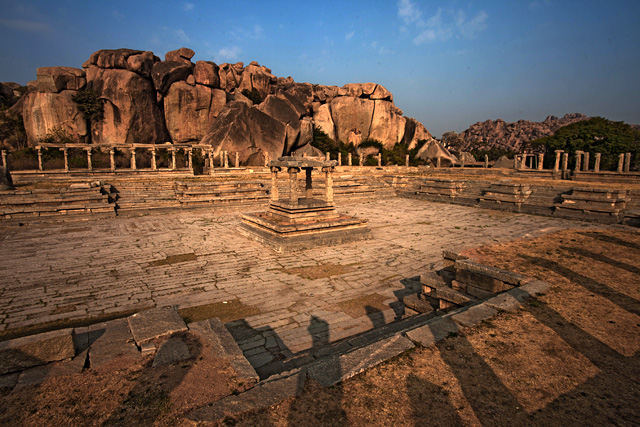
River Tungabhadra flows through Hampi, flowing close to Virupaksha Temple and the kalyani in front of Achutaraya Temple. Further, about a kilometer downstream on the bank of the river is Vijaya Vithala Temple, one of the major monuments of Hampi. It is most known for its musical pillars and a stone chariot in the temple courtyard. My personal favourite is this frangipani tree that adds a great charm to the temple premises. Thankfully, it was flowering during my last visit in February.
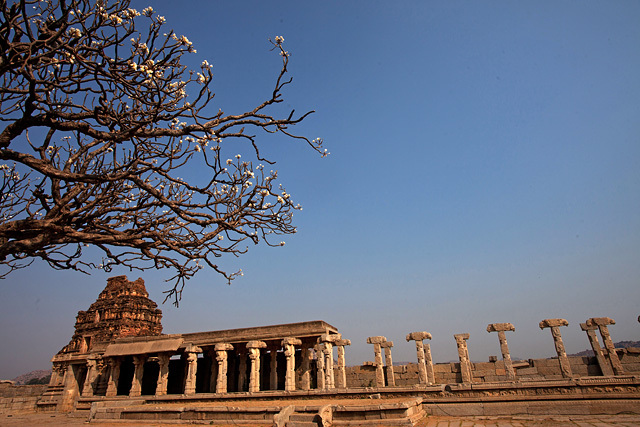
Lotus Mahal is another well-known monument in Hampi, located along with a series of sites that one can visit along with this. During my visit to the Mahal in January, we reached here just before sunset to catch the last golden rays of sun falling on the monument.
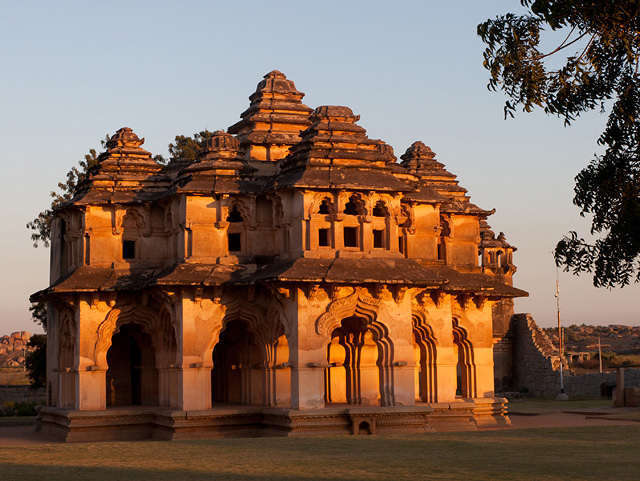
A closer look at Lotus Mahal.
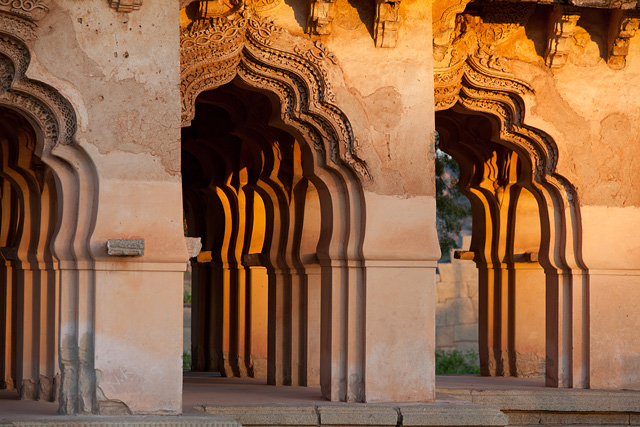
Near Lotus Mahal is a large enclosure where the royal family lived. The palace and other buildings in the enclosure do not exist any more. A large elevated platform from which the king addressed his subjects, and a series of tanks and aqueducts form the highlight of the royal enclosures. Here is a small section of a step well in the royal enclosure.
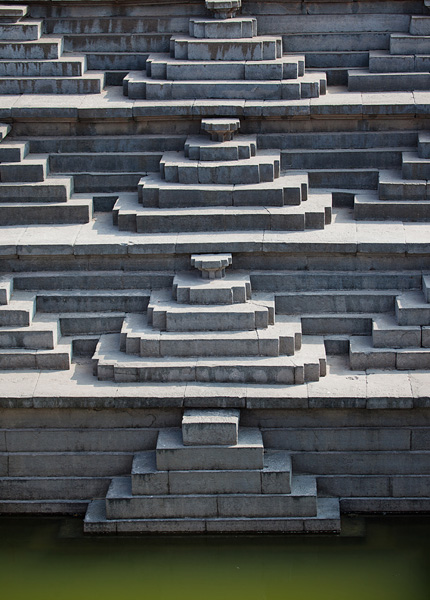
Not far from royal enclosure is the queen’s bath – a modest building with a tank in the center of it. Here is an image of the passage around the tank.
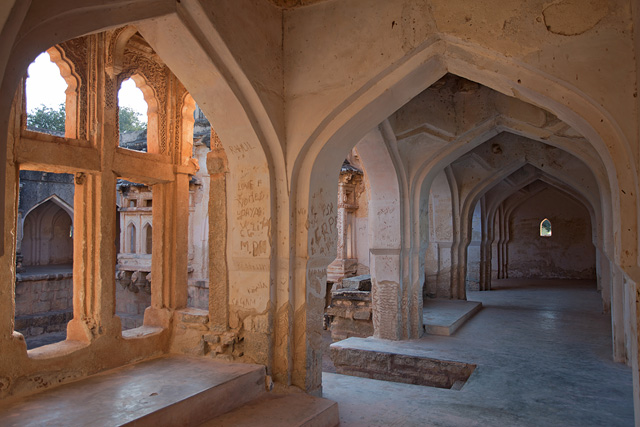
Prints of the image available. Request for prints




 The image of this little fellow in Thangu Village is northern parts of Sikkim is perhaps the only image I have, of children in Sikkim. It is long time since I backpacked in Sikkim, a place I long to go back to but the the ordeal of reaching there keeps me out. Those were the days when I was shooting with a film camera and focused on photographing landscapes and only landscapes. Hopefully I will return there soon someday to get another dose of this beautiful mountain state.
The image of this little fellow in Thangu Village is northern parts of Sikkim is perhaps the only image I have, of children in Sikkim. It is long time since I backpacked in Sikkim, a place I long to go back to but the the ordeal of reaching there keeps me out. Those were the days when I was shooting with a film camera and focused on photographing landscapes and only landscapes. Hopefully I will return there soon someday to get another dose of this beautiful mountain state.










































